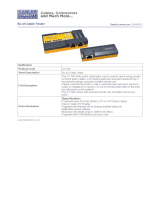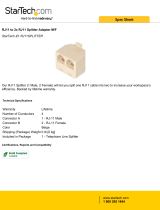
ENGLISH
The top line of the display shows the cable type test
mode or tone generation mode.
“Pass” will be on if the cable is a
properly wired 4-pair T568A/B data cable, a 3-pair one-to-
one wired voice cable or a video cable with no faults. In
addition, the “X-over” illuminates if a properly wired cross-
over (uplink) cable is recognized, or the “Rev” illuminates if
the cable is a properly wired reverse-pinned voice cable. The
wire map will show actual pin connections.
The “Fail” icon will be on only if the cable is
not wired to one of the cabling standards. An open or short
error takes precedence over miswires and the appropriate
icon(s) illuminates. The “Split” icon illuminates if the
designated pairs are not twisted together in the cable, an
Each press of the Voice button causes one test to be
run on the 6-position RJ jack and the results displayed. The
Pro 2 will turn off after 20 seconds automatically.
®
Pro 2 will turn off after 20 seconds automatically.
®
If the button is pressed and held until “LOOP ON” is displayed,
tests are run continuously and the display updated until the O/
ID button is pressed or after 5 minutes of no change in results.
Three hash marks will alternately light up on the display to
show the tester is in continuous mode. Continuous mode is
useful for trouble-shooting intermittent problems.
Pressing the Video button starts the ID test, testing
“Shielded” illuminates when a shielded data cable is properly connected at both ends. It will be flashing if there is a
short to a wire in the cable along with that pin number and the “Short” indicator.
The top line displays the pins on the tester end in order. These pins are mapped to the pins on the
remote-end shown directly below them on the LCD.
The bottom line displays the corresponding pin on the remote-end. Dash lines on the remote line
indicate shorted pins. No pin numbers displayed on the remote line are open pairs. "U" indicates an unknown continuity, usually
The battery low symbol illuminates when the battery is nearing depletion. The symbol will begin to flash when the
battery needs to be replaced. Results may be unreliable at this point.
In the video or the ID modes, the “ID” icon will be on with the number of the remote ID displayed or an error
message of “Open” or “Short”. In continuous cable test mode, three segments will light up in turn to show when the tester is
running subsequent tests.
9. Voltage Detected Warning:
If voltage is detected on any of the tester connectors, the “Voltage!” icon is turned on. A check
for voltage is performed before each test and if found, no test is run. The tester should be disconnected immediately from the
only for the F-connector, because the video continuity test is the same as the ID test. The test loops continuously until the O/ID
button is pressed or for 5 minutes after last change in ID status.
Each press of the Data button causes one test to be run on the 8-position RJ jack and the results displayed. The VDV
Pro 2 will turn off after 20 seconds automatically. If the button is pressed and held until “LOOP ON” is displayed, tests
®
Pro 2 will turn off after 20 seconds automatically. If the button is pressed and held until “LOOP ON” is displayed, tests
®
are run continuously and the display updated until the O/ID button is pressed or after 5 minutes of no change in results. Three
hash marks will alternately light up on the display to show the tester is in continuous mode. Continuous mode is useful for
finding intermittent problems.
When Tone is pressed, the VDV Scout
Pro 2 begins sending an audio tone for the connector last tested with the pins
®
Pro 2 begins sending an audio tone for the connector last tested with the pins
®
and cadence previously selected for that connector type. To change the connector type, press a different connector type button.
Pressing the same connector type button again will change the pins carrying the tone. Pressing the Tone button will cycle
through the available tone cadences. To turn the VDV Scout
Pro 2 off, press the O/ID button. The VDV Scout
®
Pro 2 off, press the O/ID button. The VDV Scout
®
turn off automatically 60 minutes after the last button press. The tone is compatible only with analog tone tracers such as the
Klein Tools VDV500-060 or VDV526-054. It will not be audible without the aid of an analog tone probe.
Pressing O/ID will turn off the VDV Scout
Pro 2 when it is on in any mode. With the VDV Scout
®
Pro 2 when it is on in any mode. With the VDV Scout
®
®
Pro 2 off, pressing the
®
O/ID button starts the ID test mode. The ID test mode scans for all possible ID types – voice, video and data. The “ID” icon and
a progression of “o” are displayed on the bottom line of the display to indicate scanning is active. If no ID remotes are found,
“Open” is displayed. When an ID remote is found, the connector type and the ID number are displayed. If multiple ID remotes
are found, the ID or fault is displayed in sequence. The test loops continuously until the O/ID button is pressed or for 5 minutes
after last change in ID status.
The RJ jacks share internal connections so only one RJ cable can be connected at a time for accurate cable test results.
However, an RJ cable and a coax cable may be connected at the same time. In ID mode, all connectors on the VDV Scout
2 may be connected at the same time.
9
1
2
3
4
5
6
7
8
ID
D
E
A B C
















